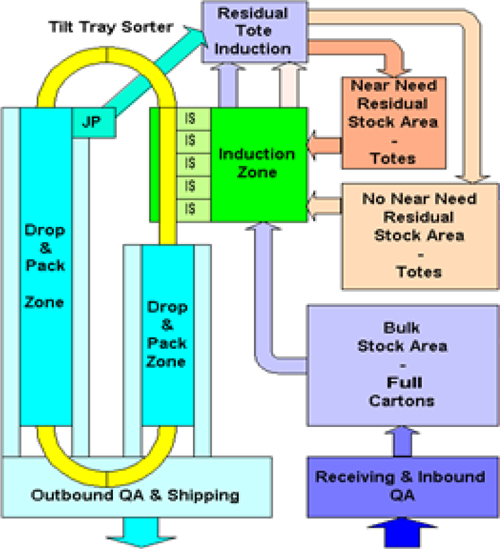Lowest CapEx System Using Article Sorters
Many piece-picking systems use tilt tray, Bombay or other types of article sorters to process orders. This paper describes an example of a very low capitalization cost order fulfillment “pull” system using a tilt tray sorter for filling of piece picked orders. The system is based on the design model of “Quick Access Residual Storage (QARS)” (see IIE Solutions May 1997). An interesting feature of this system is the absence of conveyance systems. The system is controlled by the Mandate® AWMS™.
At the heart of the system is a 640-drop station, single induction zone tilt tray sorter. Each of the drop stations has an active order accumulation queue and a packing shelf. The order accumulation queue is separated from the packing shelf by a gate, which is automatically activated by Mandate to release a completed order into the packing shelf as necessary.
The induction zone consists of five SOFT™ purpose-built manual induction stations controlled by Mandate. Product is delivered to induction stations in both full cartons and in “residual” totes uniquely identified by license plate number (LPN).
Most of the product is stored in the bulk stock area. All product in this area is in full cartons. This area is serviced by Mandate equipped Crown SP3000 Stock Selectors for both put-away and retrieval of stock for order fulfillment. The area has both full pallet storage locations and loose individual carton storage shelves. Product is randomly stored (not in fixed locations) in this area. Mandate tracks the stock location of all cartons in this area. Residual stock is that stock which is “left over” after a full carton is opened and its needed product used to fill in-process orders. The QARS model attempts to have only one residual container per SKU.
The residual stock is held in one of two areas. One area is for stock that is not needed for immediately foreseeable orders (“No Near Need” area). This area must have at least enough locations to hold one tote for each SKU. The other area is used for temporarily holding the stock that will shortly be needed for new orders. This area is called the “Near Need” area. This application does not “classify” stock into fast or slow mover categories. Mandate dynamically determines the best area to hold the residual stock based on future order needs. The “No Near Need” totes are stacked on a pallet for random put away into a case rack storage location by a stock picking (also known as cherry picker) vehicle. The “Near Need” area totes are equipped with an inexpensive battery powered OnSite Paging Systems “Container Pager” (patent pending).

The “Near Need” totes are placed on shelves very near the sorter induction stations until Mandate “pages” the tote. This tote is then removed by the worker for re-delivery to sorter induction. The Container Pager has a high intensity light that indicates to the worker the tote is being paged. There is no need to scan totes for either put-away or retrieval in this area.
Operational Flow Overview
Mandate receives ASN (advanced ship notice) information for inbound cartons. Upon receiving trailer arrival, cartons are unloaded and sample audited for shipment integrity. Individual cartons are loaded onto mixed SKU pallets for put-away. The Mandate AWMS allows operational procedures to control the put-away process wherein receipt acknowledgement may occur as the result of unloading the trailer, inspection of goods, loading onto pallets for put-away, or the actual put-away itself. Mandate tracks the location of all product and reports stock positions to an external financial system.
Mandate receives customer orders from a Web enabled order entry and processing entry system. Mandate responds to the order processing system with an “order acceptance” confirmation and an “order shipped” notification. Orders are maintained by Mandate for processing based on the order ship date and priority received from the order processing system.
A “Pending Order” queue is maintained by Mandate. Mandate selects the highest priority shippable orders that will soon be picked and puts them into this queue. This application uses a virtual wave in operating the sorter. A “virtual wave” is defined as a wave where, as existing orders complete and are released from the drop station to the packing shelf, new orders are removed from the “Pending Order” queue and assigned to the newly available drop station.
The Mandate AWMS selects stock to fill orders. The rules for making stock selections are first to empty any residual totes containing needed stock. If there is insufficient residual stock for completing orders, additional needed stock is selected from the full carton storage area. Stock is selected for the orders that are both actively picking and that are in the “Pending Order” queue. Mandate directs the retrieval of selected stock, sequencing the selection to maximize the completion of orders.
Mandate directly controls the induction process itself and the use of an AWMS allows the induction process to be handled independently from the stock selection and delivery process. The induction process is only concerned about filling orders and has no concern from whence the stock came. Any stock delivered to the station will be examined to determine if it could be used to fill orders. If so, Mandate will direct the workstation operator to induct product until either there is no longer a need for the product or the container is emptied. Of course Mandate tracks stock usage. These features allow stock to be manually and independently retrieved from a trailer in the inbound yard and delivered to the sorter induction station. The AWMS adapts to the situation, by updating the receiving system indicating the carton had been received, recording the carton was at the sorter induction, and then completing any orders requiring the stock and updating the carton contents to indicate any remaining stock
Once a carton or tote is no longer currently needed (completed or emptied) at the sorter induction station, it is delivered to an area called “Tote Induction”. Mandate directs the work in this area through Symbol Technologies Model 1700 Palm Based terminals. Empty cartons are put on a chute down to the packing area for shipping use. Empty totes are removed and stacked and any “Container Pager” removed. Cartons with remaining product are scanned into an empty tote. Full totes are scanned for their routing disposition, either to “Near Need” or the “No Near Need” area. If the tote is to be sent to the “No Near Need” area any “Container Pager” is removed. If the tote is to be sent to the “Near Need” area, and if there is an available “Container Pager”, the “Container Pager” is scanned linking it to the tote.
The sorter packing stations are serviced by purpose built SOFT™ mobile pack services stations controlled by Mandate. Workers are directed to orders ready for packing. The mobile pack service stations contain packing cartons, packing material, and shipping label printers. Once cartons are packed and labeled they are stacked on the floor where another worker gathers and delivers them to shipping for sample audit and trailer loading.

